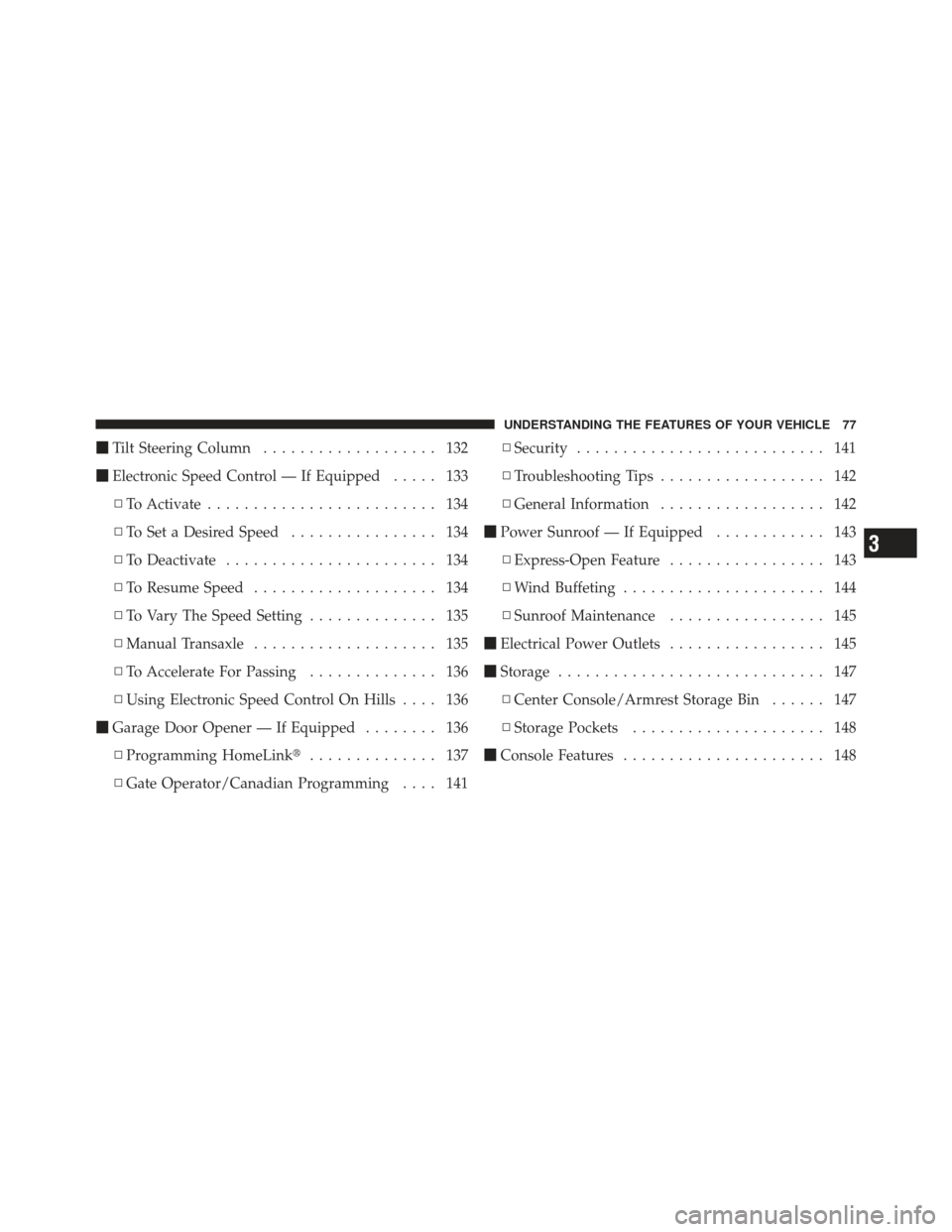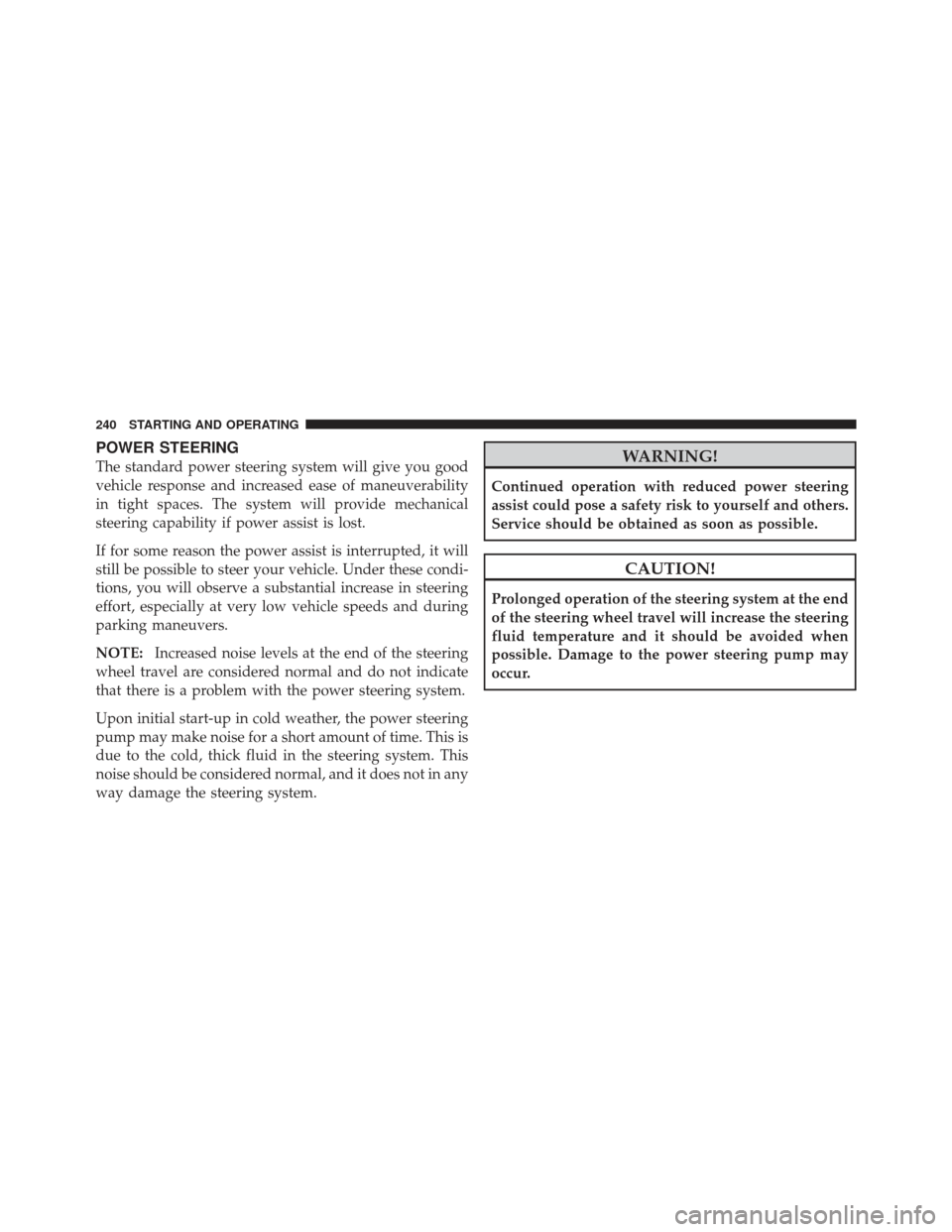Page 16 of 410

CAUTION!
An unlocked vehicle is an invitation to thieves.
Always remove the key from the ignition and lock all
doors when leaving the vehicle unattended.
Manual Transaxle — If Equipped
Turn the ignition switch to the ACC position, push the
key and cylinder inward, rotate the key to the LOCK
position, and remove the key.
Locking Doors with a Key
You can insert the key with either side up. To lock the
door, turn the key rearward. To unlock the door, turn the
key forward. For door lock lubrication, refer to “Body
Lubrication” in the “Maintenance Procedures” section of
this manual.
Key-In-Ignition Reminder
Opening the driver’s door when the key is in the ignition,
sounds a signal to remind you to remove the key.
NOTE:With the driver’s door open, and the key in the
ignition, both the power door locks and Remote Keyless
Entry (RKE) will not function.
STEERING WHEEL LOCK — IF EQUIPPED
Your vehicle may be equipped with a passive steering
wheel lock. This lock prevents steering the vehicle with-
out the ignition key. If the steering wheel is moved
approximately a half turn in either direction and the key
is not in the ignition switch, the steering wheel will lock.
To Manually Lock the Steering Wheel
With the engine running, turn the steering wheel upside
down, turn off the engine and remove the key. Turn the
steering wheel slightly in either direction until the lock
engages.
14 THINGS TO KNOW BEFORE STARTING YOUR VEHICLE
Page 75 of 410

Airbag Warning Light
The light should come on and remain on for six to eight
seconds as a bulb check when the ignition switch is first
turned ON. If the light is not lit during starting, see your
authorized dealer. If the light stays on, flickers, or comes
on while driving, have the system checked by an autho-
rized dealer.
Defroster
Check operation by selecting the defrost mode and place
the blower control on high speed. You should be able to
feel the air directed against the windshield. See your
authorized dealer for service if your defroster is
inoperable.
Periodic Safety Checks You Should Make Outside
the Vehicle
Tires
Examine tires for excessive tread wear and uneven wear
patterns. Check for stones, nails, glass, or other objectslodged in the tread. Inspect the tread and sidewall for
cuts and cracks. Check the wheel nuts for tightness.
Check the tires (including spare) for proper pressure.
Lights
Have someone observe the operation of exterior lights
while you work the controls. Check turn signal and high
beam indicator lights on the instrument panel.
Door Latches
Check for positive closing, latching, and locking.
Fluid Leaks
Check area under vehicle after overnight parking for fuel,
engine coolant, oil, or other fluid leaks. Also, if gasoline
fumes are detected or if fuel, power steering fluid, or
brake fluid leaks are suspected, the cause should be
located and corrected immediately.
2
THINGS TO KNOW BEFORE STARTING YOUR VEHICLE 73
Page 79 of 410

�Tilt Steering Column ................... 132
� Electronic Speed Control — If Equipped ..... 133
▫ To Activate ......................... 134
▫ To Set a Desired Speed ................ 134
▫ To Deactivate ....................... 134
▫ To Resume Speed .................... 134
▫ To Vary The Speed Setting .............. 135
▫ Manual Transaxle .................... 135
▫ To Accelerate For Passing .............. 136
▫ Using Electronic Speed Control On Hills .... 136
� Garage Door Opener — If Equipped ........ 136
▫ Programming HomeLink� .............. 137
▫ Gate Operator/Canadian Programming .... 141▫
Security ........................... 141
▫ Troubleshooting Tips .................. 142
▫ General Information .................. 142
� Power Sunroof — If Equipped ............ 143
▫ Express-Open Feature ................. 143
▫ Wind Buffeting ...................... 144
▫ Sunroof Maintenance ................. 145
� Electrical Power Outlets ................. 145
� Storage ............................. 147
▫ Center Console/Armrest Storage Bin ...... 147
▫ Storage Pockets ..................... 148
� Console Features ...................... 148
3
UNDERSTANDING THE FEATURES OF YOUR VEHICLE 77
Page 82 of 410
Outside Mirror — Passenger Side
Adjust the convex outside mirror so you can just see the
side of your vehicle in the part of the mirror closest to the
vehicle.
WARNING!
Vehicles and other objects seen in the passenger side
convex mirror will look smaller and farther away
than they really are. Relying too much on your
passenger side mirror could cause you to collide with
another vehicle or other object. Use your inside
mirror when judging the size or distance of a vehicle
seen in this convex mirror.
Power Mirrors — If Equipped
The power mirror switch is located to the left of the
steering column on the instrument panel. To adjust the
view in the outside mirrors, turn the rotary knob to the L
(Left), O (Center) or R (Right) position. After selecting themirror, move the knob in the same direction you want the
mirror to move. Use the O (Center) position to guard
against accidentally moving a mirror position.Power Mirror Switch
80 UNDERSTANDING THE FEATURES OF YOUR VEHICLE
Page 157 of 410
Rear Wiper/Washer Switch — If Equipped
A switch on the right side of the steering column controls
operation of the Rear Wiper/Washer function. Rotating
the center of the switch forward to the on position will
activate the wiper. Rotating the center of the switch all
the way forward will turn on the wash function. The
washer pump will continue to operate as long as the
button is pressed. Upon release, the wipers will cycle two
times before returning to the set position.If the rear wiper is operating when the ignition is turned
OFF, the wiper will automatically return to the “Park”
position if power accessory delay is active. Power acces-
sory delay can be cancelled by opening the door. If this
happens the rear wiper will stop at its current position
and will not go to “Park”.
Rear Wiper Switch
3
UNDERSTANDING THE FEATURES OF YOUR VEHICLE 155
Page 224 of 410

�Driving On Slippery Surfaces ............. 236
▫ Acceleration ........................ 236
▫ Traction ........................... 237
� Driving Through Water ................. 237
▫ Flowing/Rising Water ................. 238
▫ Shallow Standing Water ............... 238
� Power Steering ....................... 240
▫ Power Steering Fluid Check ............. 241
� Parking Brake ........................ 241
� Brake System ........................ 243
▫ Anti-Lock Brake System (ABS) —
If Equipped ........................ 244
� Traction Control System — If Equipped ...... 246�
Tire Safety Information ................. 248
▫ Tire Markings ....................... 248
▫ Tire Identification Number (TIN) ......... 251
▫ Tire Loading And Tire Pressure .......... 252
� Tires — General Information ............. 256
▫ Tire Pressure ....................... 256
� Tire Chains .......................... 263
� Snow Tires .......................... 264
� Tire Rotation Recommendations ........... 264
� Tire Pressure Monitoring System (TPMS) ..... 265
▫ Base System ........................ 267
� Fuel Requirements ..................... 270
▫ 2.4L And 2.4L Turbo Engines ............ 270
222 STARTING AND OPERATING
Page 242 of 410

POWER STEERING
The standard power steering system will give you good
vehicle response and increased ease of maneuverability
in tight spaces. The system will provide mechanical
steering capability if power assist is lost.
If for some reason the power assist is interrupted, it will
still be possible to steer your vehicle. Under these condi-
tions, you will observe a substantial increase in steering
effort, especially at very low vehicle speeds and during
parking maneuvers.
NOTE:Increased noise levels at the end of the steering
wheel travel are considered normal and do not indicate
that there is a problem with the power steering system.
Upon initial start-up in cold weather, the power steering
pump may make noise for a short amount of time. This is
due to the cold, thick fluid in the steering system. This
noise should be considered normal, and it does not in any
way damage the steering system.WARNING!
Continued operation with reduced power steering
assist could pose a safety risk to yourself and others.
Service should be obtained as soon as possible.
CAUTION!
Prolonged operation of the steering system at the end
of the steering wheel travel will increase the steering
fluid temperature and it should be avoided when
possible. Damage to the power steering pump may
occur.
240 STARTING AND OPERATING
Page 243 of 410

Power Steering Fluid Check
Checking the power steering fluid level at a defined
service interval is not required. The fluid should only be
checked if a leak is suspected, abnormal noises are
apparent, and/or the system is not functioning as antici-
pated. Coordinate inspection efforts through an autho-
rized dealer.
CAUTION!
Do not use chemical flushes in your power steering
system as the chemicals can damage your power
steering components. Such damage is not covered by
the New Vehicle Limited Warranty.
WARNING!
Fluid level should be checked on a level surface and
with the engine off to prevent injury from moving
parts and to ensure accurate fluid level reading. Do
not overfill. Use only manufacturer’s recommended
power steering fluid.
If necessary, add fluid to restore to the proper indicated
level. With a clean cloth, wipe any spilled fluid from all
surfaces. Refer to “Fluids, Lubricants, and Genuine
Parts” in Section 7 for the correct fluid type.
PARKING BRAKE
When the parking brake is applied with the ignition on,
the “Brake Warning Light” in the instrument cluster will
come on.
NOTE: This light only shows that the parking brake is
on. It does not show the degree of brake application.
5
STARTING AND OPERATING 241